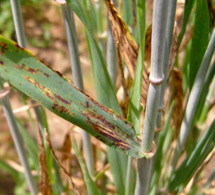Description
Symptoms of SFNB are mostly found on leaves but can also be found on leaf sheaths. Lesions begin as a small, round, dark brown spots which elongate into blotches varying from 3-10 mm long. Lesions are often surrounded by a yellow margin or chlorotic zone, particularly near the leaf tip. Older leaves tend to have more lesions compared to younger leaves.
SFNB survives on infected stubbles, infected barley seed and sometimes barley grass residues. Spores on infected stubbles can remain viable for up three years. Primary infection occurs when spores from infected stubbles are released at the break of season and dispersed by the wind, infecting barley seedlings. Successful infection requires warm temperatures (15 – 25 °C) and moist conditions. Secondary infections can occur several times during the season from lesions which produce and release spores, infecting more plants. Humid conditions following flowering can cause seed to become infected, however this is not considered a major source of primary inoculum with SFNB.
As well as SFNB, barley crops can be subject to net form net blotch. Refer to the link below for more detailed information on net form net blotch in barley.
Control
Effective management of SFNB is achievable by using a range of tactics. Avoid planting barley on barley and allow a lengthy break between barley crops, particularly in medium to high rainfall zones or where SPNB is known to be an issue. In high risk areas avoid sowing susceptible varieties, instead select varieties with resistance. Removal of infected stubbles by burning, where wind erosion risks are low, can also help reduce disease levels.
Early sown crops are at increased risk of infection, therefore delaying sowing may help reduce infection, however it is important to consider the economic impacts associated with delayed sowing. Crops deficient in potassium are often more susceptible to leaf diseases, so if economical, applying potassium may reduce infection risk.
Seed infection is not considered as big a factor in SFNB compared to net form net blotch. However, if seed is believed to be infected, either source new seed or apply seed dressings which may provide some level of protection for seedlings. Monitor crops for disease symptoms and apply a foliar application of fungicide when required. Prosaro® and Aviator® Xpro® have both preventative and curative properties and both are registered for the control of SFNB in barley. Consult CropLife Fungicide Resistance Management Strategies as a guide to the responsible use of fungicides and always follow the product label for specific use instructions.






